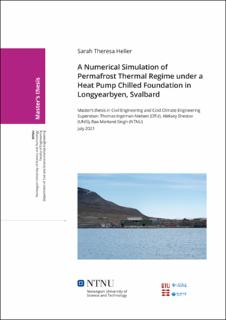| dc.description.abstract | Climate change in the Arctic causes a critical warming of the permanently frozen subsoil. The livelihood of over 3 million people is affected by the projected degradation of permafrost until 2050. The sustainable development of permafrost regions must address the need for special foundation solutions to found structures on steadily warming ground. The thermal regime is disturbed when a structure is placed on permafrost. Heat loss through the floor of the building can cause major degradation of frozen ground. Tailored permafrost engineering solutions are available to mitigate the effects of climate change and local human-induced warming on the subsoil. Modern solutions aim to maintain the thermal regime in the subsoil and thus mitigate frost heave and thaw settlements in the ground. Freeze-thaw action can lead to a loss of structural integrity as the soil's strength highly decreases upon thawing and pore water expands 9% upon freezing.
An attractive foundation solution in view of climate change lies in the active cooling of the subsoil under a structure. The ground source heat pump technology, widely used in milder climates as a source of renewable energy, is adapted to permafrost application to permanently keep the ground frozen. A heat-pump powered system extracts heat from the ground via ground loops and a heat carrier fluid. The heat lost through the floor of the building can be extracted from the ground and the soil can further be cooled to a desired temperature. The active control of the systems enables to adapt the system to changing climatic conditions.
This study focuses on a current heat-pump cooling project in Longyearbyen, the largest settlement in Svalbard. A foundation area of 3400 m² is permanently cooled during the lifetime of the building. A verified 3D model is built to simulate the ground's thermal regime under a cooling plate. The results identify the corner area close to the ocean as the most critical area with the warmest ground temperatures. A cooling temperature of -5°C is risky, especially in view of climate warming and it is found that a temperature of -10°C is more suitable for the project. An estimate of annual operational expenses concludes that the cost lies between 16 000 and 54 000 NOK, dependent on the heat-pump efficiency and the cooling temperature. A well-controlled monitoring system is an integral part of this technology to avoid undetected power failure which is found to warm the ground by 4°C in one year.
The technology can be optimized in different ways. The study of seasonal operation shows that the ground remains frozen also when the cooling system is turned off for three consecutive months in winter. This implies that the system can be turned off during some months in the darker seasons and powered with solar energy in warmer seasons. These results consequently highlight the development possibility to a self-sustained cooling system which can be coupled with a renewable energy source, such as solar energy, to power the system. | |
